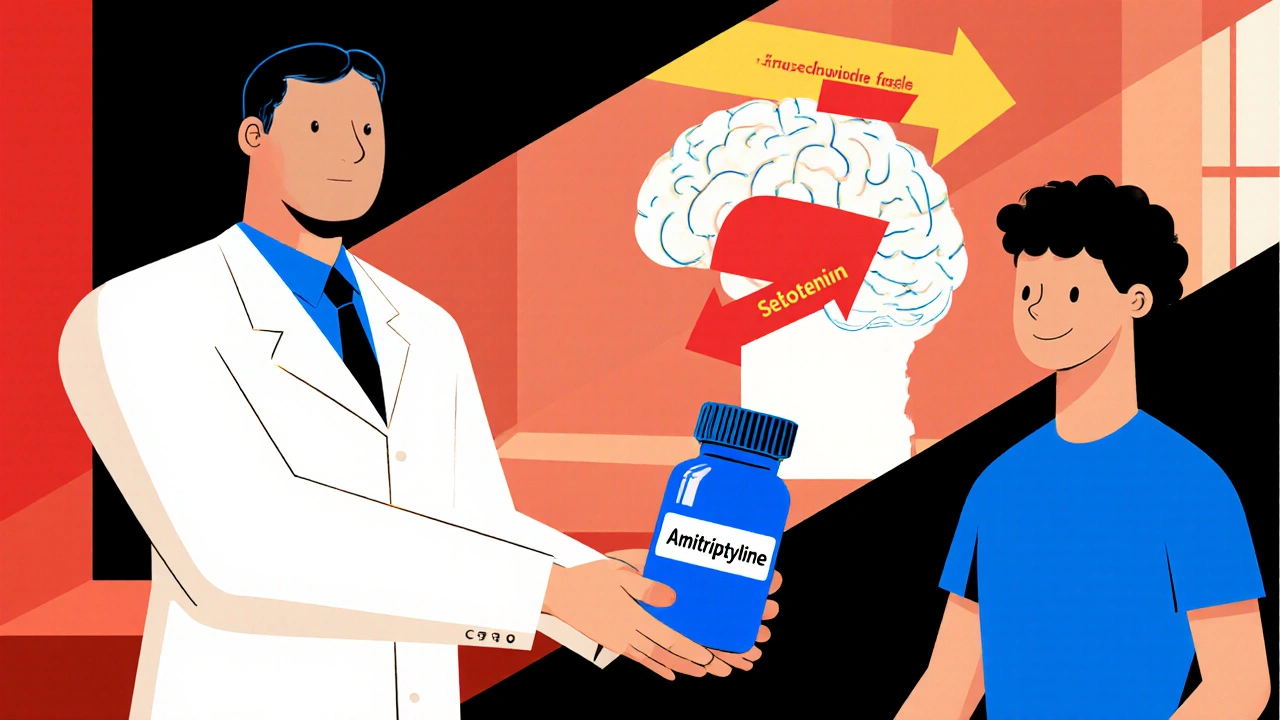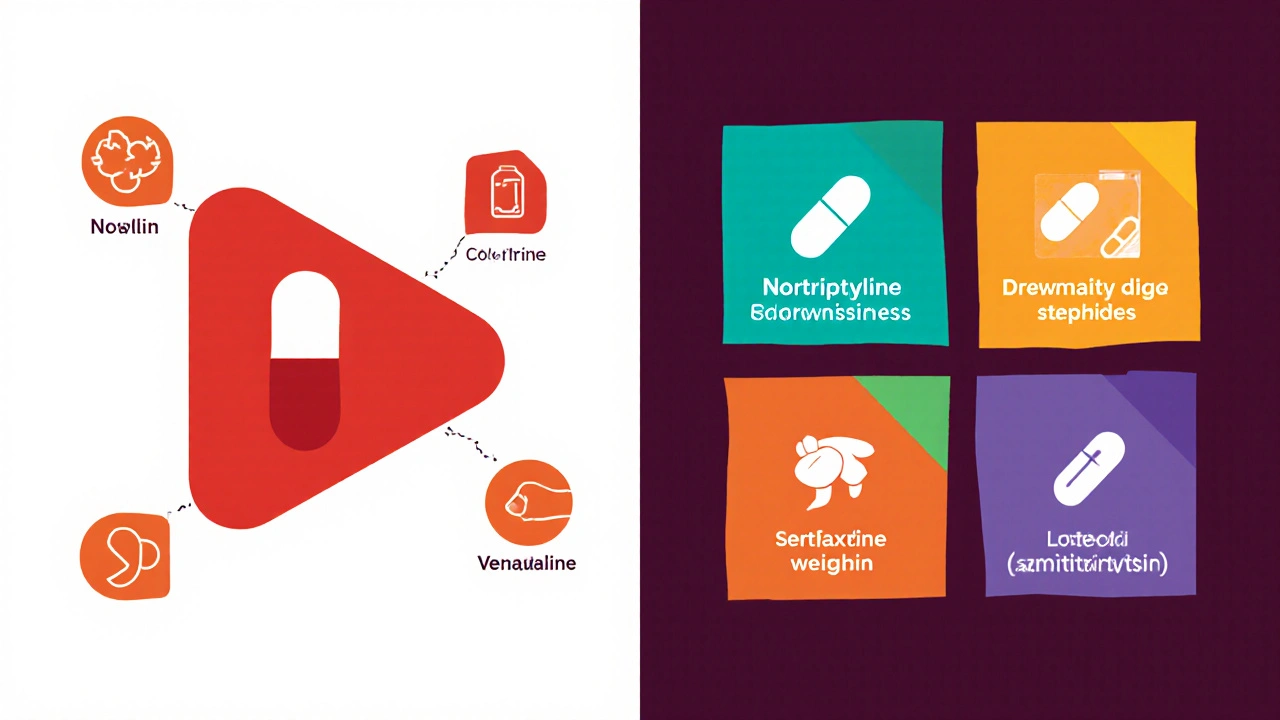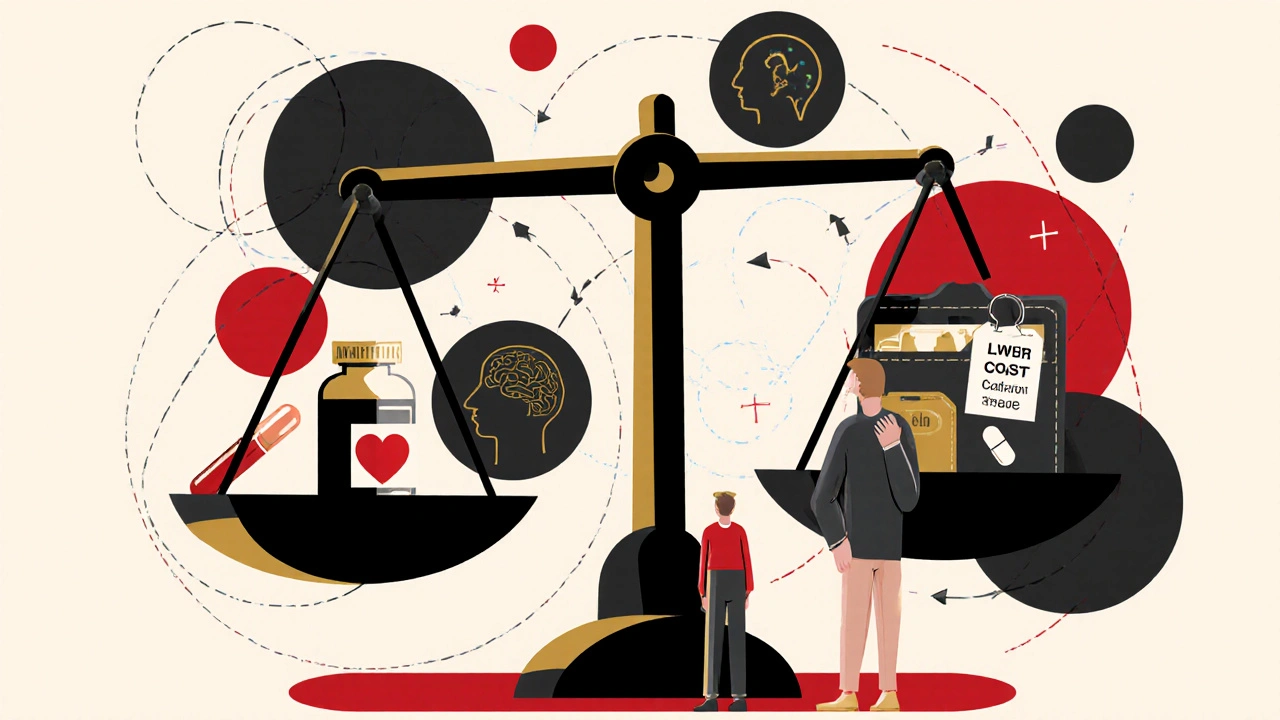
Medication Selector Tool
Choose your primary condition and key considerations to see which medications might be best suited for your situation.
Your Situation
How This Works
We analyze your inputs against key criteria:
- Effectiveness for your condition - How well each drug treats your primary issue
- Side effect profile - Which drugs minimize your most concerning side effects
- Age considerations - Safety for your age group
- Cost factors - Monthly price and insurance coverage
Based on your selections, we'll recommend 1-3 medications that best match your needs.
Important: This is an informational tool only. Always discuss treatment with your doctor.
When doctors prescribe a mood‑lifting or pain‑relief pill, they often start with amitriptyline because it’s cheap and works for many conditions. But it’s not the only option, and its side‑effect profile can be a deal‑breaker for some patients. This guide walks you through what amitriptyline actually does, compares it side‑by‑side with the most common alternatives, and helps you decide which drug fits your situation best.
What is Amitriptyline?
Amitriptyline is a tricyclic antidepressant (TCA) that was first approved in the 1960s. It works by increasing the levels of serotonin and norepinephrine in the brain, which helps lift mood and soften pain signals. Typical doses for depression start at 25 mg nightly and can be increased up to 150 mg, while for neuropathic pain the dose often stays lower (25‑75 mg). Common side effects include dry mouth, drowsiness, weight gain, and constipation. Because it can affect heart rhythm, doctors usually order an ECG for patients over 60 or those with cardiac history.
How Amitriptyline Works
The drug blocks the reuptake of two key neurotransmitters-serotonin and norepinephrine-allowing them to stay longer in the synaptic gap. This dual action makes amitriptyline effective for both mood disorders and chronic pain syndromes such as fibromyalgia, migraine, and diabetic neuropathy. Its anticholinergic properties (the cause of dry mouth and blurred vision) are a double‑edged sword: they can help with certain types of tremor but also increase the risk of urinary retention, especially in older adults.
Common Alternatives to Amitriptyline
Below are the most frequently prescribed alternatives, grouped by class.
Other Tricyclic Antidepressants
Nortriptyline is a close cousin of amitriptyline but is slightly more selective for norepinephrine, often causing fewer anticholinergic side effects. It’s a go‑to when patients can’t tolerate the heavy sedation of amitriptyline.
Desipramine leans even more toward norepinephrine, making it useful for attention‑deficit disorder and certain neuropathic pains, though it may raise blood pressure in some users.
Imipramine was the first TCA on the market and is still used for bed‑wetting in children and nocturnal enuresis, besides depression.
Doxepin has strong antihistamine effects, which makes it a choice for severe itching (pruritus) and insomnia, but it can be potent at causing weight gain.
Selective Serotonin Reuptake Inhibitors (SSRIs)
Sertraline is an SSRI that blocks only serotonin reuptake. It’s lighter on the anticholinergic side and works well for depression, anxiety, and obsessive‑compulsive disorder. However, it may not be as effective for neuropathic pain as the TCAs.
Citalopram offers a similar profile to sertraline but with a slightly lower risk of sexual side effects. It’s often chosen for patients who need a gentle start.
Serotonin‑Norepinephrine Reuptake Inhibitors (SNRIs)
Venlafaxine boosts both serotonin and norepinephrine, much like a TCA but without the strong anticholinergic activity. It’s effective for major depressive disorder and certain chronic pain conditions, though it may increase blood pressure at higher doses.

Side‑Effect Profiles at a Glance
| Drug | Class | Typical Uses | Common Side Effects | Cost (US$ per month) |
|---|---|---|---|---|
| Amitriptyline | TCA | Depression, neuropathic pain, migraine prophylaxis | Dry mouth, drowsiness, weight gain, constipation | 5‑10 |
| Nortriptyline | TCA | Depression, chronic pain | Less sedation, still dry mouth, dizziness | 7‑12 |
| Sertraline | SSRI | Depression, anxiety, PTSD | Insomnia, diarrhea, sexual dysfunction | 12‑20 |
| Venlafaxine | SNRI | Depression, generalized anxiety, neuropathic pain | Hypertension, nausea, sweating | 15‑25 |
| Doxepin | TCA | Itching, insomnia, depression | Weight gain, strong sedation | 8‑15 |
Choosing the Right Medication
Picking a drug isn’t just about efficacy; it’s a balance of several factors:
- Condition being treated - TCAs shine for mixed pain‑depression cases, while SSRIs are preferred for pure anxiety.
- Side‑effect tolerance - If dry mouth or weight gain are deal‑breakers, a SNRI or SSRI may be gentler.
- Drug interactions - Amitriptyline inhibits several CYP enzymes (CYP2D6, CYP2C19). Patients on heart meds or certain antipsychotics need careful monitoring.
- Age and comorbidities - Older adults often avoid TCAs because of heart‑arrhythmia risk; low‑dose SSRIs become the default.
- Cost and insurance coverage - Generic amitriptyline remains the cheapest, an attractive point for long‑term pain management.
In practice, a clinician might start with a low dose of amitriptyline for nighttime pain, then switch to nortriptyline if sedation is too strong, or to venlafaxine if blood pressure is a concern.

Managing Common Side Effects
Even the best‑chosen drug can cause unwanted reactions. Here are quick fixes:
- Dry mouth - Sip water frequently, chew sugar‑free gum, or use saliva substitutes.
- Drowsiness - Take the dose before bedtime; if daytime sleepiness persists, reduce the dose or switch to a less sedating option.
- Weight gain - Track calories, add light exercise, and discuss possible dose adjustments with your prescriber.
- Constipation - Increase fiber, stay hydrated, and consider a mild stool softener.
- Blood pressure spikes (SNRI) - Monitor weekly for the first month, and reduce dosage if readings exceed 140/90 mmHg.
When to Seek Professional Help
If you notice any of the following, call your doctor immediately: severe heart palpitations, sudden mood swings, suicidal thoughts, or an allergic reaction (hives, swelling). Regular follow‑ups are crucial, especially during the first 4‑6 weeks when the drug stabilizes.
Bottom Line
Amitriptyline remains a solid, low‑cost choice for many patients, but its anticholinergic side effects and cardiac considerations mean it isn’t the best fit for everyone. Alternatives like nortriptyline, sertraline, and venlafaxine offer tailored profiles-whether you need fewer sedative effects, a cleaner heart‑risk picture, or a more modern mechanism. Talk with your healthcare provider about the specific symptoms you’re trying to treat, any existing health concerns, and your lifestyle goals. Together you can land on the medication that offers the best balance of relief and tolerability.
What conditions is amitriptyline most commonly prescribed for?
Amitriptyline is typically used for major depressive disorder, chronic neuropathic pain, migraine prevention, and sometimes for insomnia or restless leg syndrome.
How does amitriptyline differ from newer antidepressants like sertraline?
Amitriptyline blocks both serotonin and norepinephrine reuptake and has strong anticholinergic effects, leading to more sedation and dry mouth. Sertraline is an SSRI that targets only serotonin, generally causing fewer anticholinergic side effects but may be less effective for certain pain conditions.
Can amitriptyline be used safely in older adults?
It can be used, but doctors usually start at a very low dose (10‑25 mg) and monitor heart rhythm closely because TCAs can affect cardiac conduction in older patients.
What are the main reasons to switch from amitriptyline to nortriptyline?
Nortriptyline tends to cause less sedation and fewer anticholinergic side effects while maintaining similar antidepressant efficacy, making it a good fallback if patients find amitriptyline too drowsy.
Is it okay to combine amitriptyline with over‑the‑counter pain relievers?
Generally yes, but NSAIDs like ibuprofen can increase the risk of stomach irritation, and combining with other sedatives (e.g., antihistamines) may amplify drowsiness. Always check with a pharmacist.









9 Comments
In practice, clinicians often start amitriptyline at 25 mg at night because the sedative effect can aid sleep while managing neuropathic pain. The drug’s low price-typically $5‑10 per month-makes it a first‑line choice for many insurers.
Switching to nortriptyline can cut down on daytime drowsiness.
Got to love that there are so many options beyond the old tricyclics; sometimes a simple SSRI like sertraline does the trick for mood without the heavy sedation.
Honestly, TCAs feel outdated and the anticholinergic side‑effects are a nightmare for most patients.
While the discourse surrounding amitriptyline often neglects its nuanced pharmacodynamics, one must appreciate the drug’s dual reuptake inhibition as a testament to early psychopharmacological ingenuity.
Nonetheless, it would be misguided to proclaim newer agents inherently superior; the extensive longitudinal data on amitriptyline’s efficacy and safety profile cannot be dismissed lightly.
Seems like the table covers the basics, but I’m not convinced any of these meds are a magic bullet.
India has always taken pride in making healthcare accessible, and generic amitriptyline is a perfect example of that ethos! It costs pennies compared to branded SSRIs, allowing families to afford long‑term therapy without breaking the bank! The drug’s ability to tackle both depression and neuropathic pain in one pill is a logistical marvel that many modern compounds simply cannot match! Yes, the dry mouth and weight gain are real concerns, but with proper lifestyle adjustments they become manageable nuisances rather than deal‑breakers! Hydration, sugar‑free gum, and a balanced diet can mitigate most anticholinergic complaints! Moreover, for patients living in rural areas where regular monitoring is scarce, the simplicity of a nightly dose is a blessing! Doctors can start at 25 mg and titrate slowly, observing tolerability without expensive lab work! The cardiovascular precautions are valid, yet with low‑dose regimens and ECG screening, the risk remains minimal! In comparison, newer serotonergic agents often require frequent blood tests to monitor metabolic effects! From a public health perspective, prescribing a cost‑effective, well‑studied medication aligns with national interests! The pharmaceutical industry’s push for patented alternatives sometimes obscures the benefits of tried‑and‑true generics! Patients deserve the choice to opt for an affordable option that has stood the test of time! While personalized medicine is the future, we must not discard the value of broad‑spectrum drugs like amitriptyline! It remains a cornerstone in our therapeutic armamentarium, especially for low‑resource settings! So, let’s celebrate the humble tricyclic for its resilience and continue to use it wisely!
Thanks for laying out the pros so clearly; patients really benefit from a balanced view that acknowledges both cost and side‑effects.